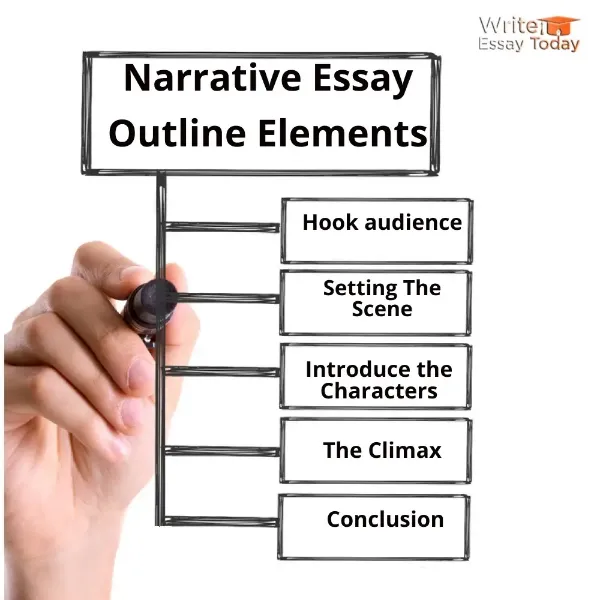New here? Signup with us
Already have an account? Login with us
- Have any questions?
- 866-388-7579 (Toll Free)
- 786-697-1078 (Text/Call)
- [email protected]

Detailed Guide on How to Write a Narrative Essay Outline with Tips
- Post on October 21, 2023
- By Oliver Jack
Are you interested in taking your audience on a journey through your storytelling? Or perhaps you've been assigned a narrative essay and aren't quite sure where to begin? Crafting a compelling narrative essay outline is the key to unlocking your storytelling potential. This blog by WriteEssayToday explains how to create a narrative essay outline , including helpful advice and a real-world example. Here you'll discover:
What is a Narrative Essay?
- What Should You Do Before Writing Your Outline?
- How To Structure Your Outline Of Narrative Essay
Tips For A Flawless Narrative Essay Outline
- Narrative Essay Outline Example And Template
Together, let's create a narrative outline that has a lasting impact
A narrative essay is a brief story with a revolving central idea. You can explore emotions, share personal experiences, and demonstrate your storytelling skills. But how do you get started? Crafting a stellar narrative essay outline is the key to ensuring your narrative flows seamlessly.
What Makes a Narrative Essay Unique
Storytelling is unique, in all forms of presentation. They provide a forum for exchanging insights, tales, and emotions. Unlike informative writing, narrative aims to engage readers in the author’s world. These stories establish a close connection with the viewer by using a first-person point of view and adopting a voice.
What do you need to do before writing your outline?
Before you start planning your story, it’s important to complete a few important steps that will prepare the ground for it. These early actions include:
- Think about memorable experiences.
- Consider the mood and characters.
- Develop character personality and quirks.
- Imagine and describe vivid situations.
- Communicate the emotions involved.
- Plan the structure of your story.
- Gather the right things.
- Prioritize fat writing before perfection.
What Makes a Good Narrative Outline? & How to Structure One
Consider your narrative essay outline as the blueprint for your masterpiece. It ensures your story develops logically and keeps your readers interested from beginning to end. Let's get into the elements of a well-crafted narrative essay outline:

1. Hook Your Audience
This is the first step and perhaps most important one. The introduction is your chance to grab your reader's attention. Engage their curiosity with a captivating hook. You can use a quote, a question, or even a startling fact. Make sure your introduction sets the stage for the story you're about to tell.

2. Setting the Scene – Where and When
Make a background for your story in this section. Talk about a crowded metropolis, a sandy beach, or a dark wilderness. Your readers will experience being present with you. Use familiar materials to give your surroundings life.
3. Introduce the Characters – The Heart of the Tale
Your characters are the heart of your story. Whether you’re on a road trip with your best friend, or a mysterious stranger you meet overseas, present them in a way that makes your readers care about their trip. Create a connection by showcasing their personalities, quirks and emotions.
4. The Climax – The Moment of Truth
The ending is where your story reaches its conclusion. It's a moment that builds to every, "Aha!" or "Uh-oh!" second. Here, enthusiasm and feelings of excitement are at their highest. Make this part memorable by using verbs that have obvious action and description.
5. Conclusion – Wrapping it Up
In conclusion, tie up the loose ends of your narrative. Think about the journey you took the reader on and what you learned or gained from the experience. Leave readers with something to think about, a text or a thought-provoking question.
Keep it Personal and Authentic
Your narrative essay tells your story, so be sure to be yourself. Be genuine, and don't be afraid to express your honest feelings. Your readers will identify with this authenticity, which will strengthen the narrative's impact.
Show, Don't Tell
Show your readers the actions and feelings rather of only reporting the facts. Create rich picture by using descriptive words, metaphors, and similes. Allow your readers to see the narrative from your perspective.
Embrace the Power of Dialogue
Dialogue is a fantastic tool for breathing life into your narrative. It gives the narrative more realism by letting your characters talk for themselves. Use dialogue tags to ensure that the interaction is clear and interesting.
It is sometimes a bit tricky to make your outline. This is why students often seek expert assistance. It is one of the advantages of Using Essay Writing Services that students learn more quickly.
Narrative Essay Template
The final thoughts.
Narrative essays are unique since they are storytellers, emotional experiences, and personal journeys. With a strong narrative essay outline as your guide, you can write a captivating story that grips your audience and leaves a lasting impact. So begin your fictional adventure right now.
And, if you ever need help creating a narrative essay outline, don't hesitate to contact WriteEssayToday . Our expert narrative essay writers are here to help you through the writing process and ensure that your stories stand out. After all, their blog is a showcase for their narrative skills. So, channel your inner storyteller and let your stories shine.

- Free Unlimited Revisions
- Free Proof Reading
- Free Plagiarism Report
- Free Formatting
- Premium Quality
- Deadline Driven
- 100% Confedential
- Affordable Rates
- 24/7 Customer Support
- Native US Writers

Our website uses cookies to improve your experience. Please give us your consent.

IMAGES
VIDEO